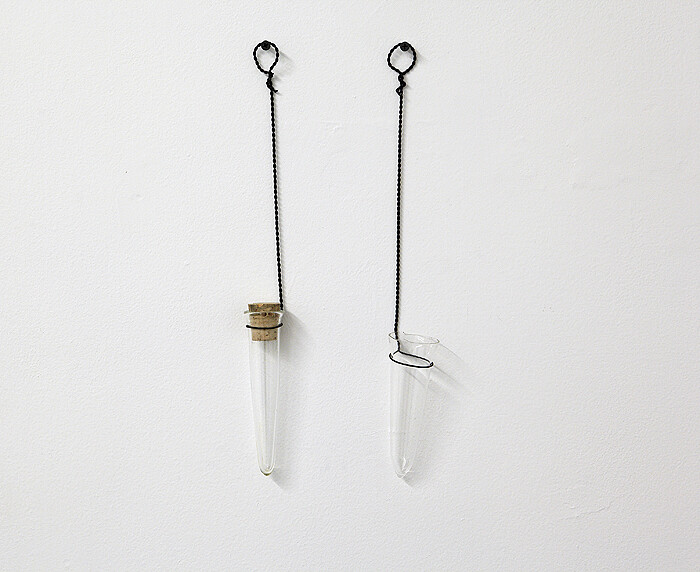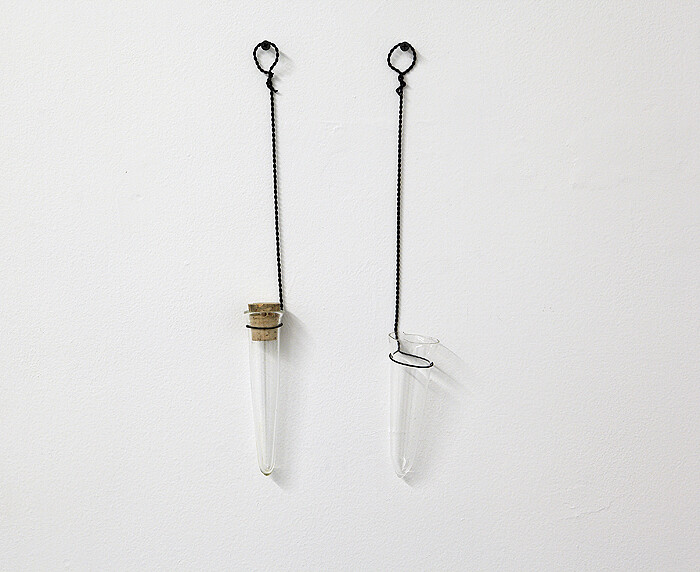A clear glass valve on a strand of silver party beads beckons from the entrance to Eli Hansen’s exhibition, “Next time, they’ll know it’s us.” Dangling from a nail, it gives off a felonious pong, like those signs of a subculture that pass under the noses of the majority while remaining indecipherable. What lies beyond this subversive gesture, in Hansen’s second solo show at The Company, consists of a number of sculptural works of delicate blown glass paired with rough and ready found materials like reclaimed wood and steel, beakers and wire. Shelves, cobbled together from wood scraps, hold hand-blown flasks in a variety of colors. Some works carry a narrative charge, such as We bought the whole thing and only sold half (all works 2011), in which two empty vials shaped like bud vases hang from wire nooses, one corked and other portentously left open. Still others pursue more fantastic images of chemistry class gone native, for instance, in We’ll return the favor, where three ash-blackened beakers droop like pears from a curved stick, topped with a glass tip that resembles a giant glossy sprout.
Trained as a glassblower, Hansen is skilled at shuffling the conflicting roles left to the medium: decoration or paraphernalia; Murano and Chihuly or everyday pipes; vases or bongs dissimulated as animal figurines. But whereas the latter might recall the fast times of high school ceramics (playfully conjured by Hansen in a darkened storage room, where hunks of glass refract LED pedestals like lava-lamps), the paraphernalia in this exhibition takes on a darker cast. However colorful, the beakers and conduits here evoke the toxic underbelly of rural America, where meth labs pollute environments and bodies alike in regions including—and indeed, especially—Hansen’s own, the Pacific Northwest.
Hansen currently lives on the island of Vashon, Washington, situated midway between Seattle and Tacoma and accessible only by ferry. That this information unfailingly makes it into the art press (the same could be said of Hansen’s brother and frequent collaborator Oscar Tuazon, who has lived in France for years but is still framed as a PNW export) might seem warranted, in light of his ostensibly regional materials: weathered wood, gnarls of steel that look like they’ve been dug out of moist earth, and of course, the provincial medium of glass. Yet the Northwest has no particular claim on these, and still less on the trope of melding man-made and natural (consider Carol Bove). Instead, one might begin to suspect Hansen’s complicity with that same regional discourse so tightly framing his materials as semi-abstractions of seedy activities in America’s hinterlands, seat of our own homegrown exoticism. This couldn’t be any clearer than in This is how it begins, a working fountain that routes water through what is fastidiously described in the works list as a “standing Soxhlet extractor and Allyn condenser”—two devices used in meth labs.
In his landmark 1979 book on British youth subcultures, Dick Hebdige dryly noted the paradox of his enterprise: one cannot bring to light what is underground without denaturing it. Yet the desire to get a glimpse at the underbelly, to join it with the safety of our own world, persists. In the gallery’s back room, a garage converted into a white cube, Hansen cleverly obliges: a short bookcase arrayed with colorful hand-blown beakers, this last work calibrates meth-lab-meets-mid-century-design to unite “us” with “them,” delivering the fantasy of collusion suggested ambiguously in the exhibition’s title. And in fact, maybe we’re not so different after all. Consider the signs indicating the presence of a meth lab, according to the State of Washington: “Extra efforts to cover windows or have extensive security. Visitors come and go throughout the day and stay for short periods of time. Appear to have plenty of money but don’t seem to go to work.”







